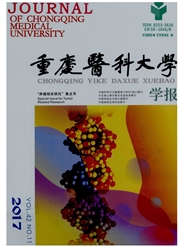

 中文摘要:
中文摘要:
目的:观察不同喂养方式对巨大儿体格发育和营养状况的影响。方法:选择在重庆医科大学附属儿童医院和重庆市妇幼保健院做儿童保健的巨大儿前瞻性队列377例,其中出生后4个月内纯母乳喂养队列155例,混合喂养队列142例,人工喂养队列80例。并于出生后1~6、8、10月和12月时测量身长、体质量,利用年龄别体质量的Z评分值评价其生长速度,身长别体质量的Z评分值评价其营养状况。结果:母乳喂养队列的体质量在10月龄和12月龄时较其余2个队列要低(10月龄时F=4.015,P=0.021;12月龄时F=5.093,P=0.008)。3个队列的身长在各个时点差异无统计学意义。3个队列的生长速度都呈现负增长,但三者之间的差异无统计学意义。3个队列的超重发生率差异无统计学意义。结论:巨大儿在1岁以内的生长速度呈现负增长;以母乳喂养为主的喂养方式能够使巨大儿的体格发育均衡,混合喂养和人工喂养可能潜在影响肥胖的发生。
 英文摘要:
英文摘要:
Objective :To observe the influences of different feeding ways on physical development and nutritional status of macrosomia. Methods :Totally 377 macrosomia were recruited from Chongqing Maternal and Child Care Service Centre and the Children's Hospital of Chongqing Medical University as subjects in this cohort study including 155 in pure breastfeeding group, 142 in partial breastfeeding group and 80 in artificial feeding group. In follow-up tracking, the weights and lengths were measured when the macrosomia at postna- tal 1-6,8,10,12 months old. Changes of weight for age Z score(WAZ) between delivery and at 12 months old was used to evaluate the growth rate;weight for length Z score(WLZ) was used to evaluate their nutritional status. Results :Weight of macrosomias was sig- nificantly lower in pure breasffeeding group than in other two groups when at 10 months old and 12 months old(10 months old:F= 4.015,P=0.021; 12 months old:F=5.093,P=O.O08). There was no significant difference in length of macrosomias among three feeding groups. Growth velocities in three feeding groups were in negative growth and there was no significant difference among them. There was no significant difference in overweight incidence among three feeding groups. Conclusions: Growth rate of macrosomia within 1 year is decreased. Pure breastfeeding as the main feeding pattern can improve the macrosomia's physical development. In addition,partial breasffeeding and formula feeding may potentially trigger the occurrence of obesity.
 同期刊论文项目
同期刊论文项目
 同项目期刊论文
同项目期刊论文
 Severe Maternal Hyperglycemia Exacerbates the Development of Insulin Resistance and Fatty Liver in t
Severe Maternal Hyperglycemia Exacerbates the Development of Insulin Resistance and Fatty Liver in t The associations of high birth weight with high blood pressure in later life: A systematic review an
The associations of high birth weight with high blood pressure in later life: A systematic review an 期刊信息
期刊信息
